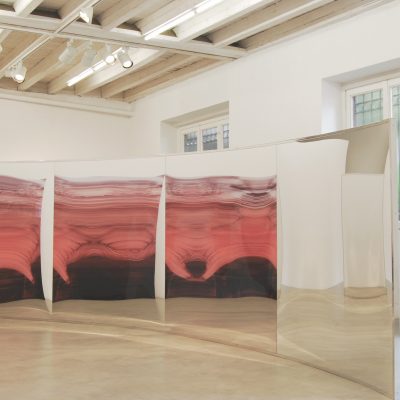Il progetto si compone di un’installazione site-spefic di grande dimensioni e di opere a muro, rispettando così ancora una volta le scelte curatoriali portate avanti dalla galleria. La mostra prende spunto dai temi proposti dal romanzo omonimo, Neuromancer, di William Gibson (1984) il quale oltre trent’anni fa già diffondeva il concetto di cyberspazio, indentificandolo come un’allucinazione consensuale creata dalla connessione di milioni di computer. Il critico letterario Larry McCaffery ha descritto il concetto della matrice di Neuromancer come “un luogo in cui i dati ballano con la coscienza umana e in cui la memoria umana è meccanicizzata”.
I dipinti di Camille Hannah sono gestuali, astratti e legati a un modello di pittura che nasce proprio dalla matrice promossa nel romanzo di William Gibson: l’artista lavora basandosi sulle tecnologie digitali e sul concetto di schermo. Camille Hannah riconosce l’influenza dello schermo sul suo lavoro e lo rende paradigma. Fa sue nozioni relative alla pittura come oggetto/superficie e alla percezione di interattività negata, data dallo schermo tecnologico. L’artista infatti coinvolge lo spettatore attraverso una pittura “sensuale” e tattile, inserendo nozioni di movimento e fluidità strutturalmente dispiegate lungo le linee di uno schermo, ma allo stesso tempo inviolabili.
The project consists of a large-scale site-specific installation and of paintings, once again in line with the curatorial choices of the gallery. The show’s starting point is to be found in the novel of the same name, Neuromancer, by William Gibson (1984) which more than thirty years ago already promoted the concept of cyberspace, which he identified as a consensual hallucination resulting from the connection of millions of computers. The literary critic Larry McCaffery has described Neuromancer’s matrix as “a place in which data dance with human consciousness and in which human memory is mechanised”.
Camille Hannah’s paintings are gestural, abstract, and linked to a model of painting derived from the very matrix promoted in William Gibson’s novel: the artist bases her work on digital technologies and on the concept of screens. Camille Hannah recognises the influence of screens on her work and turns them into a paradigm. She makes her own such notions about painting as object/surface, and the perception of negated interactivity, notions supplied by the technological screen. In fact, the artist involves the viewers by way of a “sensual” and tactile painting, and inserts ideas about movement and fluidity which are structurally laid out along the lines of a screen and are, at the same time, inviolable.



